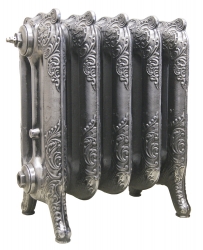Production of Cast Iron Radiators Heats Up at Castrads
Castrads has grown year on year throughout the recession, contrary to the fate of many small businesses in the area. The company thinks that this is due in no small part to its committed team of Polish labourers.

London, United Kingdom, August 27, 2010 --(PR.com)-- Since its inception five years ago, Manchester based firm Castrads has seen a huge growth in demand for traditional cast iron radiators. In sharp contrast to the plight of many small businesses, Castrads has grown year on year throughout the recession and doubled the number of full time staff from 2007 to 2010.
Why this should be so in an age of austerity completely confounds the author. However, the company could not have continued to supply top quality traditional radiators without its backbone of committed engineers, the majority of whom are recent immigrants to the UK from Poland.
The company relies heavily on the initiative and diligence of its engineers and technicians and for this reason they are paid higher than average salaries. The production team at Castrads has proved its worth, and now comprises both Poles and Brits.
One thing is certain, cast iron radiators offer an excellent alternative to steel panel radiators. More economical to run, the thick iron casting retains heat long after the boiler is turned off. More pleasing to the eye and more durable, in the right period or contemporary property a cast iron radiator will certainly make a positive impact to the design of any house.
Cast iron radiators work on the same principle as contemporary steel radiators; hot water flows around a pipe fed system, emitting heat by radiation and convection to bring the temperature of a room to a comfortable level. The heat of the radiator is regulated using a thermostatic valve, which cuts the flow of hot water into the radiator once the desired temperature is obtained.
In recent years, Castrads has seen an increasing number of inquiries regarding ground or air source heat pumps. Based on the same principle as a domestic refrigerator, heat from the ground (or air) is conducted by a mixture of water and antifreeze and passed through a heat exchanger. This concentrates the thermal energy to produce water that is hot enough to heat a home or fill a bath.
Typically the water from a ground or air source heat pump is only around 50ºC, however because the heat is constantly being renewed, the cast iron radiator need only be around 30% larger than if using a conventional boiler with a delta T of 60ºC.
Castrads
###
Why this should be so in an age of austerity completely confounds the author. However, the company could not have continued to supply top quality traditional radiators without its backbone of committed engineers, the majority of whom are recent immigrants to the UK from Poland.
The company relies heavily on the initiative and diligence of its engineers and technicians and for this reason they are paid higher than average salaries. The production team at Castrads has proved its worth, and now comprises both Poles and Brits.
One thing is certain, cast iron radiators offer an excellent alternative to steel panel radiators. More economical to run, the thick iron casting retains heat long after the boiler is turned off. More pleasing to the eye and more durable, in the right period or contemporary property a cast iron radiator will certainly make a positive impact to the design of any house.
Cast iron radiators work on the same principle as contemporary steel radiators; hot water flows around a pipe fed system, emitting heat by radiation and convection to bring the temperature of a room to a comfortable level. The heat of the radiator is regulated using a thermostatic valve, which cuts the flow of hot water into the radiator once the desired temperature is obtained.
In recent years, Castrads has seen an increasing number of inquiries regarding ground or air source heat pumps. Based on the same principle as a domestic refrigerator, heat from the ground (or air) is conducted by a mixture of water and antifreeze and passed through a heat exchanger. This concentrates the thermal energy to produce water that is hot enough to heat a home or fill a bath.
Typically the water from a ground or air source heat pump is only around 50ºC, however because the heat is constantly being renewed, the cast iron radiator need only be around 30% larger than if using a conventional boiler with a delta T of 60ºC.
Castrads
###
Contact
Castrads
Nicholas Baylis
+44 161 2970015
www.castrads.com
Nicholas Baylis
+44 161 2970015
www.castrads.com
Categories
